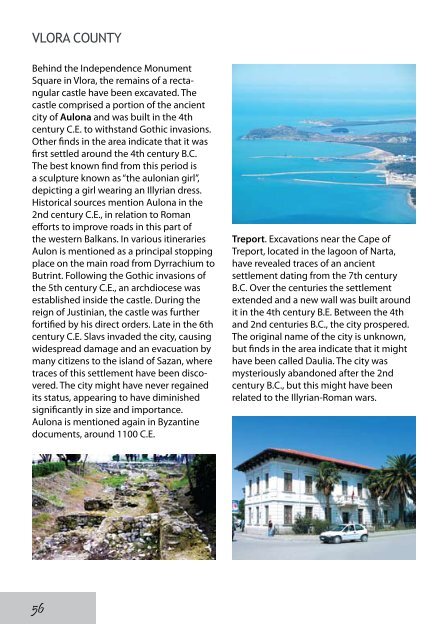Albanian Cultural Heritage
Albanian Cultural Heritage
Albanian Cultural Heritage
You also want an ePaper? Increase the reach of your titles
YUMPU automatically turns print PDFs into web optimized ePapers that Google loves.
VLORA COUNTY<br />
Behind the Independence Monument<br />
Square in Vlora, the remains of a rectangular<br />
castle have been excavated. The<br />
castle comprised a portion of the ancient<br />
city of Aulona and was built in the 4th<br />
century C.E. to withstand Gothic invasions.<br />
Other finds in the area indicate that it was<br />
first settled around the 4th century B.C.<br />
The best known find from this period is<br />
a sculpture known as “the aulonian girl”,<br />
depicting a girl wearing an Illyrian dress.<br />
Historical sources mention Aulona in the<br />
2nd century C.E., in relation to Roman<br />
efforts to improve roads in this part of<br />
the western Balkans. In various itineraries<br />
Aulon is mentioned as a principal stopping<br />
place on the main road from Dyrrachium to<br />
Butrint. Following the Gothic invasions of<br />
the 5th century C.E., an archdiocese was<br />
established inside the castle. During the<br />
reign of Justinian, the castle was further<br />
fortified by his direct orders. Late in the 6th<br />
century C.E. Slavs invaded the city, causing<br />
widespread damage and an evacuation by<br />
many citizens to the island of Sazan, where<br />
traces of this settlement have been discovered.<br />
The city might have never regained<br />
its status, appearing to have diminished<br />
significantly in size and importance.<br />
Aulona is mentioned again in Byzantine<br />
documents, around 1100 C.E.<br />
56<br />
Treport. Excavations near the Cape of<br />
Treport, located in the lagoon of Narta,<br />
have revealed traces of an ancient<br />
settlement dating from the 7th century<br />
B.C. Over the centuries the settlement<br />
extended and a new wall was built around<br />
it in the 4th century B.E. Between the 4th<br />
and 2nd centuries B.C., the city prospered.<br />
The original name of the city is unknown,<br />
but finds in the area indicate that it might<br />
have been called Daulia. The city was<br />
mysteriously abandoned after the 2nd<br />
century B.C., but this might have been<br />
related to the Illyrian-Roman wars.








